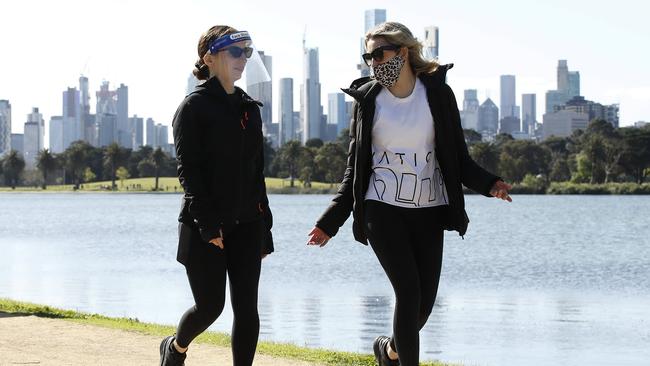Independent data reports 14-day rolling average of 2.9 in community, excluding health care cases
Melbourne is on track to meet the target of five cases to ease restrictions on October 19. But data shows our healthcare heroes are continuing to be struck down with the virus, driving up the city’s case average.
HS Coronavirus News
Don't miss out on the headlines from HS Coronavirus News. Followed categories will be added to My News.
Melbourne is on track to meet its all-important 14-day average of five cases by October 19 experts say, as new data shows we’ve already met that target by removing health care cases from the equation.
COVID LIVE, an independent data analysis website, reports the 14-day average for community cases was 2.9 — well below the five or fewer cases threshold to trigger the next stage of restriction easing.
On Thursday, 15 new cases of coronavirus were detected and Melbourne’s 14-day average was 15.6.
Data analyst Anthony Macali has been calculating figures from both state and federal health agencies, as well as media releases, since late March.
🔵 Victoria #COVID19VicData Non-Care [Sep 29]
— Anthony Macali 🌞 (@migga) September 30, 2020
Statewide 14 Day Av = 17.6
Care 14 Day Av = 14.7
Non-Care 14 Av = 2.9https://t.co/oSWfZBzSgX pic.twitter.com/gy6KZ6WPD2
Mr Macali didn’t publish the staggeringly-low community 14-day average figure to drive discussion around restriction easings.
Instead, he wanted to highlight the problem in aged care.
“I wanted to put a spotlight on certain numbers for people to interpret,” he said.
“There’s still a worry for community transmission and that’s why there needs to be more data out there so we can better assess the situation.”
Mr Macali said health care workers were still considered part of the community — and should be included in the rolling 14-day average figures — but more data was needed to answer why those outbreaks were emerging in health care.
“That’s why it’s so important to know more about these mystery cases,” he said.
“Are aged care staff getting it from the community and bringing it into the home, or are they circulating it among themselves?”

La Trobe Public Health Department epidemiologist, Associate Professor Hassan Vally said the 14-day rolling average needed to be considered as part of a wider picture.
“When you get to this point in the pandemic, (the government) is trying to make decisions on when to open up — do we set a target of a crude number and go from there, or make it a little fuzzier?” he said.
“(The government) is presumably giving people transparency by basing their decision making on a crude number so we can track how we are travelling.”
“They are not going to use that number in isolation.”
“What is really important is how much community transmission is happening. And they’ll look at all those details and then say where they think we are travelling.”
Assoc Prof Vally said we must be careful not to oversimplifying the data.
“The one thing we have learned about this pandemic is everything is connected,” he said.
“If there’s high community transmission, it’ll end up in aged care and if there’s transmission in aged care it can seep back into the community. It’s all interconnected. We need to be careful not to oversimplify what’s going on.”
In September, University of Melbourne Prof Nancy Baxter said controlling outbreaks among healthcare workers and in aged care facilities would be key to meeting the restriction deadlines.

“One of the key things is to get their house in order in respect to the hospital and healthcare worker transmission,” Prof Baxter said.
“When you have someone who is cutting stone, you make sure their mask fits so they don’t inhale the dust but they haven’t made sure the masks fit healthcare workers.”
MORE NEWS:
DAILY CASE NUMBERS: 15 NEW CASES, 800TH DEATH
WHY MELBOURNE IS ON TRACK TO MEET TARGETS
